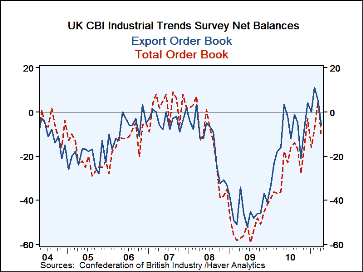 Global| Apr 26 2011
Global| Apr 26 2011UK Industrial Sector Remains Hard As Rocks But....So Do Upward Price Trends
Summary
Industrial orders continue to make gains in the uneven UK economy. The order indicator rose to plus-five in March from a reading of minus-eight in February making it the tenth largest month to month change in orders going back to [...]
Industrial orders continue to make gains in the uneven UK economy. The order indicator rose to plus-five in March from a reading of minus-eight in February making it the tenth largest month to month change in orders going back to 1989. In the UK inflation continues to mount while at the BOE Adam Posen continues to push for more quantitative easing.
Expected industrial prices have a 3-month forward-looking value that puts it in the top two percent in the expectations range since late 1989. Prices in the UK are over the top of the BOE‘s expected range and UK industrialists seem to expect this sort of pressure to continue. The inflation portion of this survey is crude, but the high level on the headline price reading suggests that inflation expectations in the UK are becoming unhinged.
While month-to-month orders are strong and growing UK external orders for exports backed off somewhat. Overall orders are still in the 89Th percentile of their range while export orders are lower in their 80th percentile. Expected output volume for the next three-months stands at a raw reading of plus-27. That reading stands in the top 11 percentile of its historic range.
If we assess the position of the industrial readings by their rankings in their respective queue of values instead of as a position between the high and low readings, the ranking metrics drop. On that basis orders are in the 59th percentile of their queue of values, export orders are in the 68th percentile of their queue, expected output is in the 73rd percentile of its queue and expected prices stand in the 71st percentile of their queue.
Ranked by their position in their respective historic queues of values the reading for the industrial sector components are relatively lower. Still as a percentile of the range they are relatively high. What this tells us is that the UK has frequently operated with readings that are this high or higher, still the readings are consistent with relatively strong economic activity and price pressures.
This is just the sort of report that makes UK Monetary Policy Committee members wish that they were retired and watching or second-guessing the decisions made by others. While the UK industrial readings are strong, other surveys on consumers and retailing have been losing momentum. Their signals are in sharp contrast with the industrial survey. This sort of division will continue to keep the monetary policy committee divided.
| UK Industrial volume data CBI Survey | ||||||||||
|---|---|---|---|---|---|---|---|---|---|---|
| Reported: | Apr 11 |
Mar 11 |
Feb 11 |
Jan 11 |
Dec 10 |
12Mo Avg |
Pcntle | Max | Min | Range |
| Total Orders | N/A | 5 | -8 | -16 | -3 | -18 | 89% | 13 | -61 | 74 |
| Export Orders | N/A | 5 | 11 | 0 | 4 | -4 | 80% | 20 | -55 | 75 |
| Stocks:FinGds | N/A | 5 | 9 | 7 | 9 | 7 | 21% | 31 | -2 | 33 |
| Looking ahead | ||||||||||
| Output Volume:Nxt 3M | N/A | 27 | 23 | 17 | 13 | 14 | 89% | 36 | -48 | 84 |
| Avg Prices 4Nxt 3m | 33 | 32 | 31 | 16 | 17 | 16 | 98% | 34 | -30 | 64 |
| From early 1989 | ||||||||||
Robert Brusca
AuthorMore in Author Profile »Robert A. Brusca is Chief Economist of Fact and Opinion Economics, a consulting firm he founded in Manhattan. He has been an economist on Wall Street for over 25 years. He has visited central banking and large institutional clients in over 30 countries in his career as an economist. Mr. Brusca was a Divisional Research Chief at the Federal Reserve Bank of NY (Chief of the International Financial markets Division), a Fed Watcher at Irving Trust and Chief Economist at Nikko Securities International. He is widely quoted and appears in various media. Mr. Brusca holds an MA and Ph.D. in economics from Michigan State University and a BA in Economics from the University of Michigan. His research pursues his strong interests in non aligned policy economics as well as international economics. FAO Economics’ research targets investors to assist them in making better investment decisions in stocks, bonds and in a variety of international assets. The company does not manage money and has no conflicts in giving economic advice.








